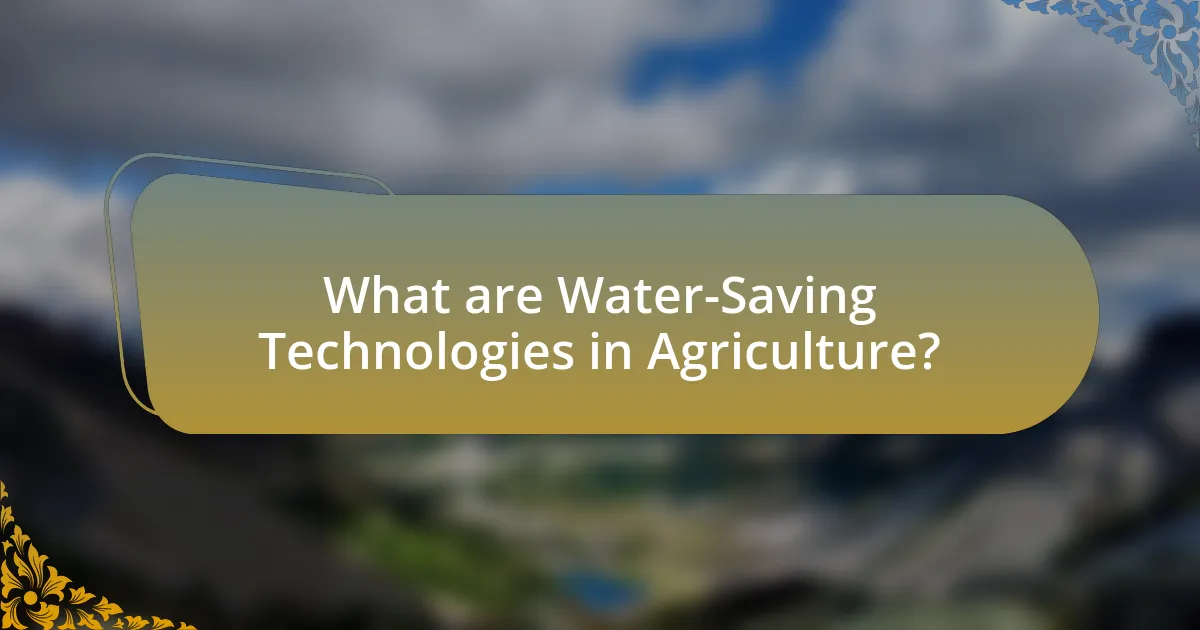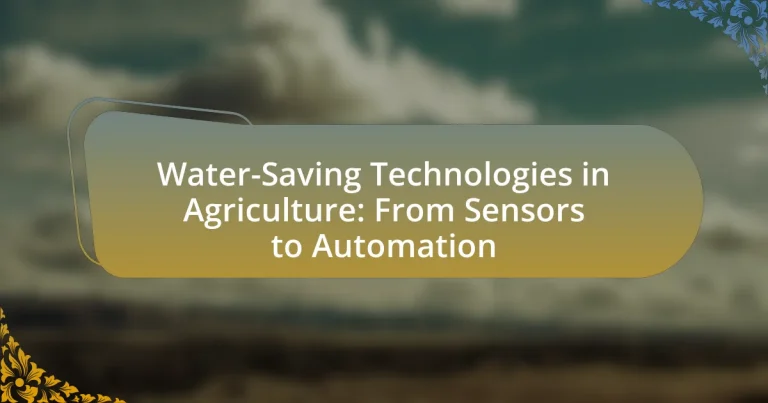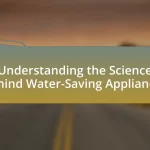Water-saving technologies in agriculture encompass innovative methods and tools aimed at optimizing water use in farming practices. Key technologies include drip irrigation, soil moisture sensors, and rainwater harvesting systems, which collectively can reduce water usage by up to 50% while maintaining crop yields. These technologies contribute to sustainable farming by enhancing efficiency, precision, and environmental conservation, while also improving crop yield and quality. The article explores the principles behind these technologies, their impact on agriculture, the challenges farmers face in implementation, and emerging trends that promise to further advance water conservation in agricultural practices.

What are Water-Saving Technologies in Agriculture?
Water-saving technologies in agriculture are innovative methods and tools designed to optimize water use in farming practices. These technologies include drip irrigation, which delivers water directly to plant roots, significantly reducing evaporation and runoff; soil moisture sensors that provide real-time data to farmers, enabling precise irrigation scheduling; and rainwater harvesting systems that collect and store rainwater for agricultural use. According to the Food and Agriculture Organization, implementing these technologies can reduce water usage by up to 50% while maintaining crop yields, demonstrating their effectiveness in promoting sustainable agricultural practices.
How do these technologies contribute to sustainable farming?
Water-saving technologies contribute to sustainable farming by optimizing water usage, reducing waste, and enhancing crop yields. These technologies, such as soil moisture sensors and automated irrigation systems, enable precise water application based on real-time data, which minimizes overwatering and conserves water resources. For instance, studies have shown that implementing drip irrigation can reduce water usage by up to 50% compared to traditional methods while increasing crop productivity by 20-30%. This efficient use of water not only supports agricultural sustainability but also helps in maintaining local ecosystems and reducing the carbon footprint associated with water transport and treatment.
What are the key principles behind water-saving technologies?
The key principles behind water-saving technologies include efficiency, precision, and sustainability. Efficiency focuses on maximizing water use while minimizing waste, often achieved through advanced irrigation systems that deliver water directly to plant roots. Precision involves using data-driven approaches, such as soil moisture sensors and weather forecasts, to optimize irrigation schedules and amounts, ensuring that crops receive the right amount of water at the right time. Sustainability emphasizes the long-term viability of water resources, promoting practices that conserve water and protect ecosystems. These principles are supported by research indicating that implementing such technologies can reduce water usage by up to 50% in agricultural settings, thereby enhancing productivity while preserving vital water resources.
How do these technologies impact crop yield and quality?
Water-saving technologies significantly enhance crop yield and quality by optimizing water usage and improving plant health. These technologies, such as soil moisture sensors and automated irrigation systems, ensure that crops receive the precise amount of water needed, reducing water stress and promoting better growth conditions. Research indicates that implementing these technologies can lead to yield increases of up to 30% in certain crops, as evidenced by a study published in the journal Agricultural Water Management, which found that precision irrigation improved both yield and quality metrics in various agricultural settings.
What types of water-saving technologies are commonly used?
Commonly used water-saving technologies include drip irrigation, rainwater harvesting, soil moisture sensors, and automated irrigation systems. Drip irrigation delivers water directly to the plant roots, reducing evaporation and runoff, and can save up to 50% more water compared to traditional methods. Rainwater harvesting systems collect and store rainwater for agricultural use, providing an alternative water source. Soil moisture sensors monitor soil moisture levels, allowing for precise irrigation scheduling, which can lead to water savings of 30-50%. Automated irrigation systems utilize technology to optimize water application based on real-time data, further enhancing water efficiency in agricultural practices.
What role do irrigation systems play in water conservation?
Irrigation systems play a crucial role in water conservation by optimizing water usage for agricultural purposes. These systems, such as drip and sprinkler irrigation, deliver water directly to the plant roots, minimizing evaporation and runoff. Research indicates that drip irrigation can reduce water usage by up to 60% compared to traditional flood irrigation methods, thereby significantly conserving water resources. Additionally, advanced irrigation technologies, including soil moisture sensors and automated scheduling, further enhance efficiency by ensuring that water is applied only when necessary, preventing over-irrigation and waste.
How do soil moisture sensors enhance water management?
Soil moisture sensors enhance water management by providing real-time data on soil moisture levels, allowing for precise irrigation scheduling. This technology enables farmers to apply water only when necessary, reducing water waste and improving crop health. Studies indicate that the use of soil moisture sensors can lead to water savings of up to 30% in agricultural practices, as they help avoid over-irrigation and ensure that crops receive adequate moisture.
Why is automation important in water-saving technologies?
Automation is important in water-saving technologies because it enhances efficiency and precision in water management. Automated systems, such as smart irrigation controllers, utilize real-time data from sensors to optimize water usage based on soil moisture levels and weather conditions. This targeted approach can reduce water consumption by up to 50%, as demonstrated in studies by the University of California, which found that automated irrigation systems significantly decreased water waste while maintaining crop health. By minimizing human error and ensuring timely responses to environmental changes, automation plays a crucial role in sustainable agricultural practices.
How does automation improve efficiency in agricultural practices?
Automation improves efficiency in agricultural practices by optimizing resource use and reducing labor costs. Automated systems, such as precision irrigation and robotic harvesting, enable farmers to apply water and nutrients more accurately, minimizing waste and enhancing crop yields. For instance, studies show that precision irrigation can reduce water usage by up to 50% while maintaining or increasing crop productivity. Additionally, automation decreases the time and labor required for tasks, allowing farmers to focus on strategic decision-making and improving overall farm management.
What are the benefits of integrating IoT in agriculture?
Integrating IoT in agriculture enhances efficiency, productivity, and sustainability. IoT devices enable real-time monitoring of soil moisture, weather conditions, and crop health, allowing farmers to make data-driven decisions. For instance, a study by the Food and Agriculture Organization (FAO) indicates that precision agriculture, facilitated by IoT, can increase crop yields by up to 20% while reducing water usage by 30%. This integration leads to optimized resource management, reduced operational costs, and improved environmental outcomes, demonstrating the significant advantages of IoT in modern agricultural practices.
How do water-saving technologies affect the environment?
Water-saving technologies positively affect the environment by reducing water consumption and minimizing the ecological footprint of agricultural practices. These technologies, such as drip irrigation and soil moisture sensors, enhance water efficiency, leading to less water extraction from natural sources. For instance, studies indicate that drip irrigation can reduce water usage by up to 60% compared to traditional irrigation methods, which helps preserve local water resources and maintain ecosystem balance. Additionally, by decreasing water runoff and soil erosion, these technologies contribute to improved soil health and reduced pollution in waterways, further benefiting the environment.
What are the ecological benefits of reducing water usage?
Reducing water usage has significant ecological benefits, including the preservation of aquatic ecosystems and the enhancement of soil health. By minimizing water consumption, less runoff occurs, which reduces the risk of nutrient and pesticide pollution in rivers and lakes, thereby protecting aquatic life. Additionally, decreased water usage promotes better soil moisture retention, leading to healthier plant growth and reduced soil erosion. According to the Food and Agriculture Organization, efficient water management can lead to a 30% reduction in water use while maintaining crop yields, demonstrating that sustainable practices can support both agricultural productivity and ecological integrity.
How do these technologies contribute to climate resilience?
Water-saving technologies in agriculture, such as sensors and automation, enhance climate resilience by optimizing water use and reducing waste. These technologies enable precise irrigation management, which conserves water resources and ensures crops receive adequate moisture even during drought conditions. For instance, soil moisture sensors provide real-time data, allowing farmers to irrigate only when necessary, thereby minimizing water consumption by up to 50%. Additionally, automated irrigation systems can adjust water delivery based on weather forecasts, further enhancing efficiency and reducing the risk of crop failure due to climate variability.
What challenges do farmers face when implementing these technologies?
Farmers face several challenges when implementing water-saving technologies, including high initial costs, lack of technical knowledge, and limited access to reliable data. The high upfront investment required for advanced systems, such as sensors and automated irrigation, can deter farmers, particularly smallholders, from adopting these technologies. Additionally, many farmers may lack the necessary technical skills to operate and maintain these systems effectively, leading to underutilization or failure. Furthermore, the effectiveness of these technologies often depends on accurate and timely data, which may not be readily available in all regions, complicating decision-making processes.
What are the economic barriers to adopting water-saving technologies?
The economic barriers to adopting water-saving technologies include high initial investment costs, limited access to financing, and uncertain return on investment. High initial costs deter farmers from purchasing advanced irrigation systems or sensors, as these technologies often require significant upfront capital. Limited access to financing options further exacerbates this issue, particularly for smallholder farmers who may lack credit history or collateral. Additionally, the uncertain return on investment creates hesitation, as farmers may be unsure if the long-term savings on water and operational costs will justify the initial expenditure. According to a study by the Food and Agriculture Organization, these economic factors significantly hinder the widespread adoption of efficient water-saving technologies in agriculture.
How can farmers overcome technical challenges in automation?
Farmers can overcome technical challenges in automation by investing in training and education to enhance their technical skills. This approach enables them to effectively utilize advanced technologies such as sensors and automated irrigation systems, which are essential for water-saving practices. Research indicates that farmers who participate in training programs are 30% more likely to successfully implement automation technologies, leading to improved efficiency and reduced water usage. Additionally, collaborating with technology providers for ongoing support and maintenance can help farmers address specific technical issues as they arise, ensuring sustained operational effectiveness.
What future trends are emerging in water-saving technologies?
Future trends in water-saving technologies include the increased adoption of precision irrigation systems, the integration of artificial intelligence for data analysis, and the development of drought-resistant crop varieties. Precision irrigation systems, such as drip and subsurface irrigation, optimize water use by delivering water directly to the plant roots, significantly reducing waste. The integration of artificial intelligence allows for real-time monitoring and analysis of soil moisture levels, weather patterns, and crop needs, enabling farmers to make informed decisions that enhance water efficiency. Additionally, advancements in biotechnology are leading to the creation of drought-resistant crops that require less water, thereby contributing to sustainable agricultural practices. These trends are supported by research indicating that precision irrigation can reduce water usage by up to 50% while maintaining crop yields, demonstrating their effectiveness in addressing water scarcity challenges.
How is research advancing the development of new technologies?
Research is advancing the development of new technologies by integrating innovative methodologies and findings that enhance efficiency and sustainability in agriculture. For instance, studies have demonstrated that the use of soil moisture sensors can significantly reduce water usage by providing real-time data, allowing farmers to optimize irrigation practices. A report by the International Journal of Agricultural Science in 2022 highlighted that farms implementing these sensors achieved up to a 30% reduction in water consumption while maintaining crop yields. Additionally, research into automation technologies, such as robotic irrigation systems, has shown potential for further minimizing water waste and labor costs, as evidenced by a 2023 study from the Agricultural Robotics Institute, which found that automated systems could improve water application accuracy by 40%. These advancements illustrate how ongoing research is crucial in developing technologies that promote water conservation in agriculture.
What role do government policies play in promoting these technologies?
Government policies play a crucial role in promoting water-saving technologies in agriculture by providing financial incentives, regulatory frameworks, and research support. These policies can include subsidies for farmers who adopt efficient irrigation systems, tax breaks for companies developing innovative water-saving technologies, and grants for research initiatives aimed at improving agricultural water management. For instance, the U.S. Department of Agriculture has implemented programs that allocate millions of dollars annually to support the adoption of precision irrigation technologies, which have been shown to reduce water usage by up to 30%. Such government interventions not only encourage the adoption of these technologies but also help in advancing sustainable agricultural practices, ultimately leading to improved water conservation and enhanced food security.
What practical tips can farmers follow to implement water-saving technologies effectively?
Farmers can effectively implement water-saving technologies by adopting precision irrigation systems, such as drip irrigation, which delivers water directly to the plant roots, minimizing evaporation and runoff. Research indicates that drip irrigation can reduce water usage by up to 50% compared to traditional methods. Additionally, farmers should utilize soil moisture sensors to monitor water levels and optimize irrigation schedules, ensuring that crops receive the right amount of water at the right time. Studies show that integrating these sensors can lead to a 20-30% reduction in water consumption. Furthermore, implementing rainwater harvesting systems can provide an alternative water source, reducing reliance on groundwater and surface water. By combining these strategies, farmers can enhance water efficiency and sustainability in their agricultural practices.


